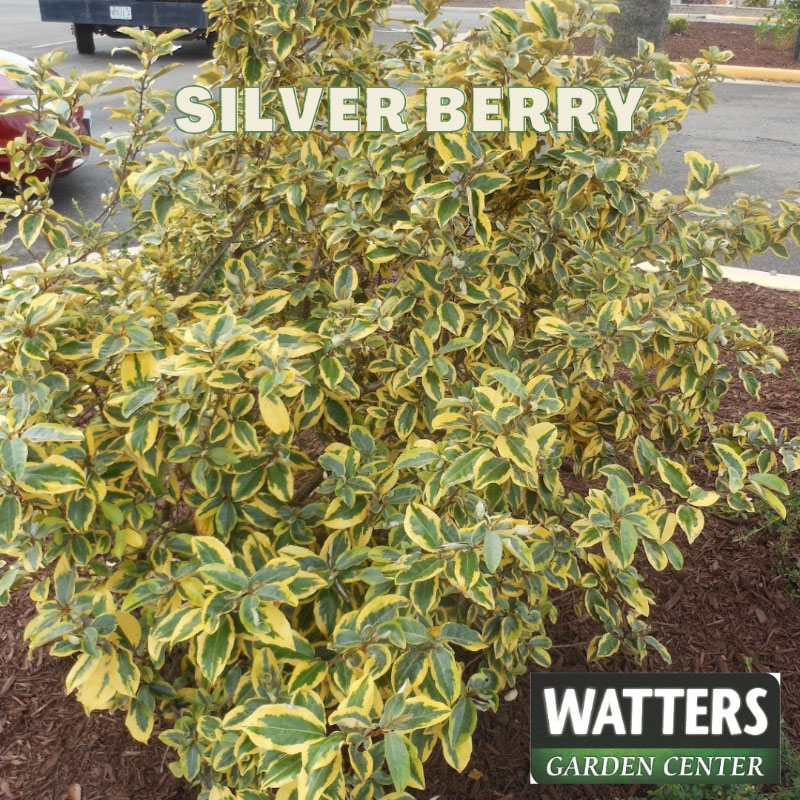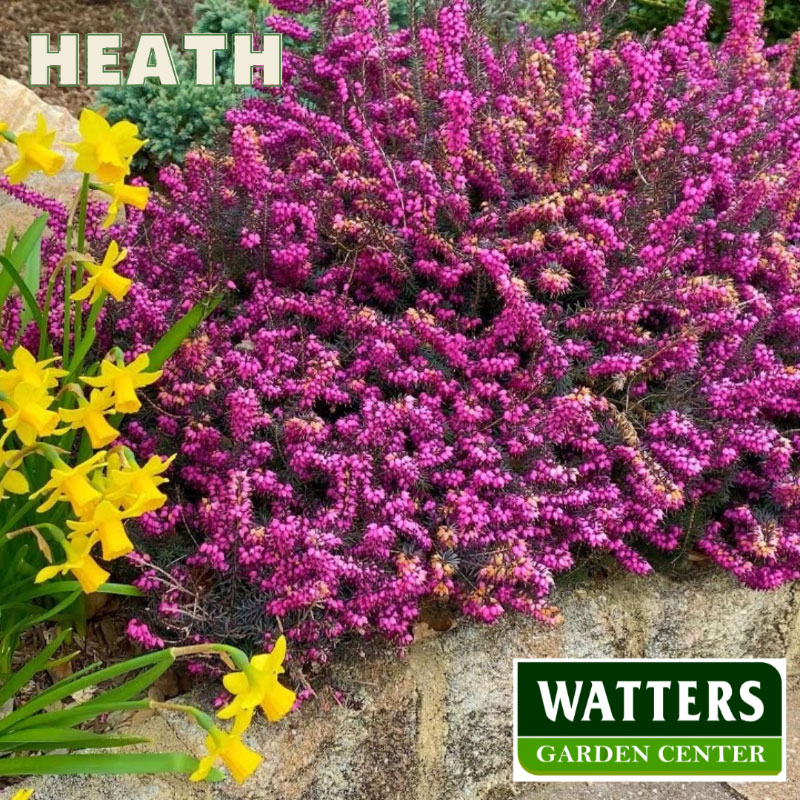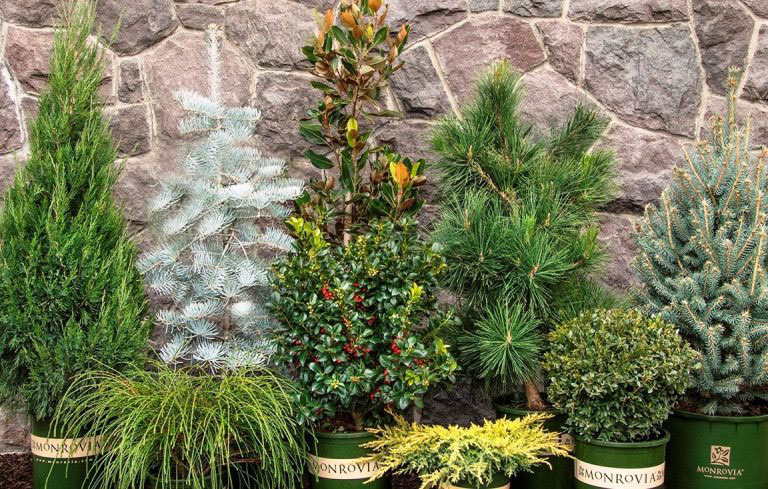Big Idea
- What shrubs look good in the winter? List of evergreen shrubs with pictures.
- What shrubs stay green all winter? Hardy winter shrubs.
- What shrubs don't lose their leaves in winter?
- Do evergreen shrubs grow in winter?
- Read more...
Autumn colors and winter evergreens!
Autumn colors are spectacular. The colors and textures are unique to the four seasons of the mountain west. As we wrap up the last Autumn leaves, the landscape can feel naked and bare. Deciduous plants, which lose their leaves through winter, often expose you to prying eyes, vehicle glare, and a yard that feels empty. Evergreens take center stage for the next few months, and you can feel when the landscape doesn't have the right mix of evergreen trees and shrubs.
Not to worry, you will find the best selection of winter evergreens at your garden center now, and it's an excellent time to plant one of your own.
Here are the Top 15 most popular evergreen shrubs planted through winter.

Blue Star Juniper– This is strictly a foliage plant. If you like the look of a blue spruce tree but lack the space for something that big, merely scale down and grow a Blue Star Juniper. With its short blue needles, it looks terrific when planted next to shrubs with golden foliage.

Boxwood – is a small, rounded evergreen that forms tufts of growth resembling clouds if left unpruned. This slow-growing dwarf form is ideal for edging borders along pathways or around flower beds. Well-suited for topiary and containers and resistant to boxwood leaf miners.

Euonymous is the most popular of the hedge plants. Although its bright year-round foliage appears almost festive, this plant is tough as they come. An ideal hedge can be sheared or left to grow into a natural form dense enough to make an excellent visual and sound barrier. For long hedgerows, a combination of the two varieties creates a more exciting entity.

Gilt Edge Silverberry – A splendid Arizona native, this shrub sports a combination of golden-yellow margins on bright green foliage that provides incredible year-round landscape interest. It's superb as a hedge or low screen that tolerates heat and wind and requires little maintenance. Tiny, fragrant, silvery flowers followed by ornamental red fruit. Impervious to both javelina and deer.

Heavenly Bamboo is evergreen with bright red highlights through winter. Bamboo-shaped foliage is graced with clusters of white flowers in spring that form red berries as summer heat arrives. Think versatility with this 3-foot tall plant, as it is happy in any amount of sun, most soils, and tolerates any amount of cold or heat.

Holly is a broadleaf evergreen that usually grows 6' x 8' feet tall. The holly leaves develop a darker color that contrasts nicely against the bright red berries. Perfect for north-facing borders, screens, hedges, and for foundation plantings. Easy to grow and impervious to mountain wildlife.

Indian Hawthorn – This easy-to-grow evergreen produces vast clusters of fragrant, pearl-pink flowers. Perfect for planting along driveways and parking medians where reflected heat is an issue for many other plants. This spring-blooming evergreen loves Arizona heat!

Mint Julip Juniper - is an improved juniper is a crisp wintergreen perfect for large hedges, privacy screens, and specimen plantings. It is so tolerant of salt, it can be used near sidewalks, driveways, and roadways. It is rarely damaged by animals, such as deer, javelina, elk, and packrats.

Mugho Pine – with its dense, symmetrical growth and compact, rounded form, this dwarf pine is perfect for confined spaces. Stunning green foliage takes on a golden hue during colder months. Its slow habit makes this evergreen an ideal specimen in smaller gardens or massed to make a bold statement in more significant landscapes.

Oregon Grape Holly is the perfect mountain evergreen often mistaken for holly. Solar yellow flowers cover the entire plant in spring, followed by a summer berry that is attractive and edible. Heading into winter, the leaves turn a mixed cranberry and orange color that remains until spring blooms. This plant loves sun, heat, wind and requires less water than many natives.

Privet has the same look as photinia but may be a better choice for a residential landscape. Growing to only six feet high, it forms a thick dark green hedge. The waxy leaves retain moisture within the plant's structure. The result is a lower maintenance hedge with lower water needs and fewer bug problems than its red-tipped counterpart.

Red Cluster Berry Cotoneaster has white flowers in spring, evolving to red berries that remain on the plant through winter. It is a welcome food source for feathered friends hanging around after welcoming in the new year. Growing 10' feet tall and wide, it loves the sun and is easy to grow.

Spreading Yew has rich green needles that border on black. The 4' x 6' foot spread is used as a hedge, screen, or border in a shaded or dapple sunspace. Scarlet berries show off against all the wintergreen and are highly attractive to birds.

Winter Heaths– first-time growers of these alpine evergreens are impressed by their long blooming period. Winter heaths, Erica darleyensis, live up to their name, putting out flowers in the most unlikely season: Winter. If the climate and conditions are suitable, they flower from late winter right through spring.

Yucca– Massed together, yuccas form an impressive display during their bloom period. 'Garland's Gold' and 'Golden Sword' are bold choices with or without remarkable flowers.
Until next week, I'll be helping local gardeners plant the best evergreens here at Watters Garden Center.
Ken Lain can be found at Watters Garden Center throughout the week, 1815 W. Iron Springs Rd in Prescott, or contacted through his websites at WattersGardenCenter.com or Top10Shrubs.com.





































